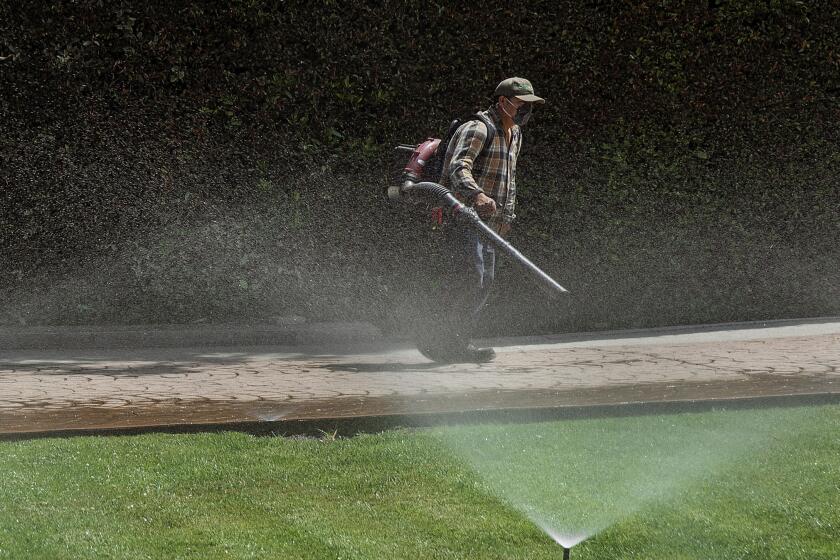LANDSCAPES : Underneath It All, Arbors Are a Living Refuge
- Share via
Arbors and pergolas have long been popular in sunny, mild climates such as ours. They date to ancient Rome, where they were made of stone pillars and wood roofing covered with climbing plants to provide shade from the sun.
The basic idea hasn’t changed much since then.
The pergola remains a place for letting the senses drink in the calm, the shade and the fragrance of the vines that grow all around.
At the core of a pergola is most typically a flat, open roof of cross rafters supported on posts or columns; an arcade is similar but has a rounded profile and is formed by a succession of arches. The general term for these and related structures that have plants growing on them is arbor.
Whether the framework is white-painted beams with scrolled ends or simply rough-barked poles, the unifying characteristic of arbors is the web of foliage they support, be it grapes, honeysuckle, bougainvillea, climbing roses, trumpet vines, pleached limes or wisteria.
“Arbors are very helpful in that they give the illusion of a ‘hanging’ garden, but you don’t have to use hanging baskets, which can be passe and take a lot of extra care,” says Jana Ruzicka, a landscape architect in Laguna Beach. Ruzicka likes to use grapevines, any type of climbing rose and “wisteria, of course, but with a large arbor and with age, it will become very heavy. Trumpet flowers are also beautiful.”
An arbor has significant advantages over a straight patio cover, Ruzicka says. “An arbor allows air circulation. There’s a big difference between sitting under a solid roof or sitting under an arbor. The air isn’t trapped underneath, and there’s a certain unmistakable freshness.”
Pergolas can be beautiful additions to a yard or the architecture of a home even if they don’t have plants growing on them.
Although they can be built of many different materials, many are of wood--particularly pine, redwood, chestnut, oak and treated Douglas fir.
“Round pieces of wood are best,” says Ruzicka, “as the wood already has everything in nature it needs to protect itself--water drains off it.” Douglas fir can be sandblasted or sandpapered to help bring out the grain and texture of the wood. She says metal framing can also work well, particularly for very heavy vines.
*
“The wonderful thing about an arbor or pergola is that it has a sense of permanence,” says Kathryn Rue of the Rue Group in Fullerton. “It’s very much like an oak tree: You build it, and chances are it’s going to stay there. It will bring you shade, but shade is many times a byproduct. I use arbors to create focal points or transitional spaces from the house to the garden.”
Rue recently constructed a series of “rooms” in John and Sarah Farmer’s Newport Beach back yard using pergola structures to simulate uncovered wall divides.
“We think this is a wonderful concept,” Sarah Farmer says. “The spaces--we call them rooms--there’s one for sun, with a chaise lounge and where my husband does his Tai Chi exercises; a dining area with table, chairs and umbrella, and a deck with furniture to look out at the sunset.”
There are two arbors; one has a slate roof leading into a separate “secret garden”--filled with ferns, foliage and a concrete garden bench.
Flooring under a pergola is important in connecting it to the house or surrounding garden. Sometimes it is possible to extend the flooring of the nearest indoor room, which gives a very strong tie. Other possibilities are batten, colored concrete, brick or flagstone.
Openings must be left near the poles for planting vines if the pergola is to have foliage.
Perennial favorites for use on arbors are Clementis, trumpet vines, yellow jasmine, passion fruit, honeysuckle, wisteria, bougainvillea and, of course, climbing roses.
Some suggestions for roses: ‘Iceberg,’ a white rose; ‘Joseph’s Coat,’ which comes in a variety of colors; ‘New Dawn,’ a rosy-color climber; ‘Bell of Portugal,’ a pinkish-white rose that does tend to become a bit unmanageable when it’s older, and ‘Golden Showers,’ a popular arbor rose.
Maintenance of arbor vines is minimal: Roses do not have to be cut back in the same manner as in a rose bed. Bougainvillea, which often becomes dead underneath, will have to be cleaned up from time to time. But on the whole, maintenance is fairly free.
Veiling the pergola with netting will add shade and catch falling leaves. General-use nursery cloth is inexpensive and typically comes in a plain weave or with a pattern of squares. It is available in many colors, but black is the most popular choice.
Even if you don’t have plants on your pergola, it gives a nice, finished look and uniform shade.
“It’s a very natural appearance to have a cut-branch arbor and shaded nursery cloth,” Ruzicka says. “Plants and vines are great, but they don’t always have to be in the design.”
*
Although a sense of permanence is something a pergola often imparts, it doesn’t necessarily have to be.
Rue has come up with a “portable” arbor.
First designed for the 1994 Orange County Philharmonic Design House, the arbor now sits in front of her own home.
“I wanted something simple, not too expensive, that people could say, ‘hey, I could even do that,’ ” explains Rue. She took large, designed terra-cotta pots and stationed the footings of the pergola inside the pots. “The idea of a transportable arbor kills just about everyone who sees it, and then they want to know how they can go about creating a similar one.”
Whether free-standing or an integral extension of the architecture of a house, pergolas have become a permanent part of the Southern California landscape.
“Something that’s lasted since ancient Rome has got to have something to it, don’t you think?” Ruzicka asks. “I’d call that something other than a passing fad.”






